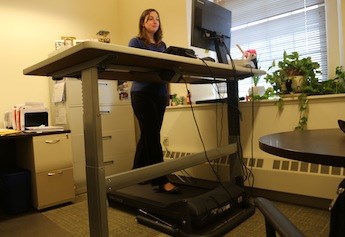Pilot Study Participants Walk to Get Job Done

02/27/2013
By Karen Angelo
Sitting all day at a desk job can be devastating to your health. In fact, it can shave years off your life. Studies show that a sedentary lifestyle causes cardiovascular disease, diabetes, obesity, depression and more.
Researchers say that while working out at the gym during leisure time helps, it’s not enough. The key is to get moving – standing and walking – throughout long days at the office to keep circulation flowing and health ailments at bay. But can office workers be productive and safe while picking up the pace?
That’s where Assoc. Prof. Manuel Cifuentes of the Work Environment Department comes in. He is testing the use of treadmills and sit-to-stand electric desks with five University employees. The volunteers began integrating movement into their daily work lives in August. Once they adapted to their new workspaces, there was no turning back.
“We’re really talking about interrupting long periods of sitting to get the body moving throughout the day,” says Cifuentes who received funding for the project from the Center for Promotion of Health in the New England Workplace’s (CPH-NEW) Pilot Grant Program. “The treadmills and stand-up desks are promising solutions to help people stay healthy but are in need of some improvements.”
After installing the treadmills and desks in the offices of five employees, Cifuentes and his research team conducted focus groups and found that most of the volunteers are using the standing desks but not the treadmills.
One of the participants, Director of Human Resources and Payroll Operations Hilary Clark, is happy with her workspace now but she didn’t feel that way at first. “In the beginning, I had the treadmill facing the corner but it was awkward and I hardly ever used it,” she says. “Then one day, I rearranged it so that my standing desk and treadmill faced forward with a small table and chairs in front for visitors.”
The set up is just one of the challenges; another is productivity. Learning what tasks you can and can’t do while walking or standing is critical to success.
“I’m finding that I can be productive on the treadmill while reading emails and talking on the phone,” says Clark. “I find it more difficult concentrating on a spreadsheet, entering information in a database and using a calculator while walking. It really is about finding what works best for you and adjusting.”
The adjustment from sitting all day to walking and standing is a process. It took users about two weeks to adjust physically. Some participants reported discomfort in their feet and knees but then the pain disappeared. In the beginning of the trial, Clark would stand for an hour or two on one day and then sit for three days straight. The key for her was rearranging her space and wearing the right shoes. Today, she stands all day and wouldn’t have it any other way.
“I feel so much better not being stuck in a chair,” she says. “My mind seems to work faster and I process information better.” “All participants are now standing all day long,” says Cifuentes. “It might not seem like much but when you stand, you are moving without realizing it.”
Don’t Take Away That Treadmill Just Yet
Use of the treadmill is not as popular as standing. Clark likes standing better than walking because she is more productive. But don’t take away that treadmill just yet.
“Even though the six-month study is over, I signed up for the next phase for three years,” she says. “I don’t think I could go back to sitting all day long. I’m determined to use the treadmill more and have some ideas on how to improve the design. I’d like a smaller treadmill and one that just turns on when you start walking without a button.”
This is exactly this type of feedback that the product manufacturers are finding valuable.
Cifuentes says: “There are some design changes that need to be made to make the treadmill safer for employees and integrate more seamlessly into workspaces. We never want to shift hazards so making sure that employees are safely adopting this technology is one of our primary goals of the research.”
That means working with manufacturers who make the equipment to improve the designs. Cifuentes recently presented the study results to insurance companies, furniture and treadmill manufacturers and educational institutions at a conference hosted by Jaymil Ergo & Office Solutions.
“Today, the ‘gym’ treadmill is not ready for mass consumption in offices,” says Cifuentes. “But with some design changes such as shortening the treadmill, limiting the miles per hour and automatic turn on, the potential for use and improving health is tremendous. In the meantime, organizations could provide employees with a shared area with treadmills where workers could sign up to walk.”
About the Center for Promotion of Health in the New England Workplace Pilot Grant Program
CPH-NEW Pilot Grant Program supports small grants of up to $12,000 per year to conduct preliminary studies or demonstration projects. Projects must relate to the National Institute for Occupational Safety and Health’s "Total Worker Health program” – the integration of occupational safety and health with workplace health promotion to prevent injury or illness and to advance health and well-being of workers. To request information, send an email to CPHNEW@uml.edu to receive the announcement for the 2013 Pilot Grant Program.
This investigation was made possible by Grant No. 2U19-OH008857 from the National Institute for Occupational Safety and Health (NIOSH). Its contents are solely the responsibility of the authors and do not necessarily represent the official views of the NIOSH.
